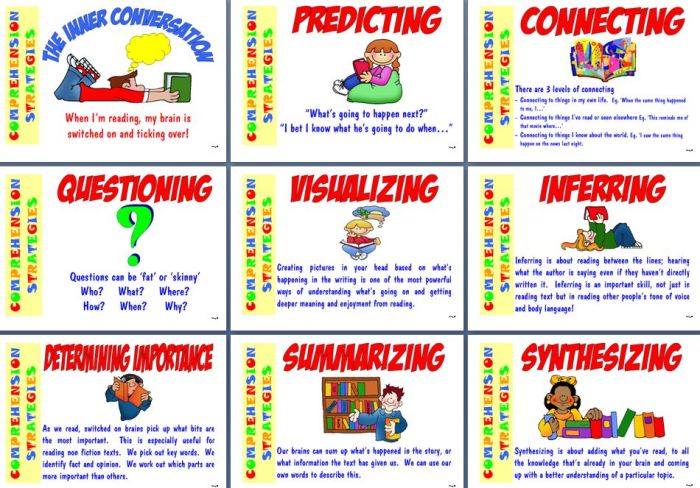
Embark on a journey to master the art of teaching reading comprehension effectively, where every word read opens new doors of understanding and knowledge. Dive into proven strategies and innovative approaches to enhance students’ comprehension skills across all subjects.
Introduction to Teaching Reading Comprehension
Teaching reading comprehension effectively is crucial for the overall academic success of students. It goes beyond just understanding the words on a page; it involves critical thinking, analysis, and interpretation of the text. Strong reading comprehension skills have a significant impact on a student’s ability to excel in various subjects and perform well in exams.
Importance of Teaching Reading Comprehension
- Enhances critical thinking skills: Reading comprehension requires students to analyze and evaluate information, leading to improved critical thinking abilities.
- Boosts academic performance: Students with strong reading comprehension skills are better equipped to understand complex texts, leading to higher grades and academic success.
- Improves communication: Good reading comprehension skills help individuals effectively communicate their ideas and thoughts, both verbally and in writing.
Impact of Strong Reading Comprehension Skills
- Better performance on standardized tests: Students with strong reading comprehension skills tend to perform better on standardized tests like the SAT and ACT.
- Success in professional life: Strong reading comprehension skills are essential in various professions, such as law, medicine, and business, where interpreting complex information is necessary.
- Enhanced problem-solving abilities: Good reading comprehension skills enable individuals to identify issues, analyze solutions, and make informed decisions.
Examples of How Good Reading Comprehension Skills Benefit Individuals
- Improved memory retention: Individuals with strong reading comprehension skills can retain and recall information more effectively.
- Enhanced empathy and understanding: Reading comprehension helps individuals empathize with characters in stories, leading to increased emotional intelligence.
- Critical analysis of media: Strong reading comprehension skills allow individuals to critically analyze news articles, advertisements, and other forms of media.
Strategies for Teaching Reading Comprehension
Effective teaching of reading comprehension involves the use of various strategies to help students understand and interpret text. Here are some practical strategies that educators can use:
1. Activate Prior Knowledge
Encourage students to connect new information with what they already know. This can help them make sense of the text and improve comprehension.
2. Teach Vocabulary Skills
Building vocabulary is crucial for enhancing reading comprehension. Introduce new words, discuss their meanings, and provide opportunities for students to use them in context.
3. Use Graphic Organizers
Graphic organizers such as mind maps, story maps, and Venn diagrams can help students visualize information and organize their thoughts while reading.
4. Predict and Infer
Encourage students to make predictions about the text before reading and to infer meaning based on clues within the text. This can improve their comprehension skills.
5. Ask Questions
Teach students how to ask questions before, during, and after reading. This helps them engage with the text and deepen their understanding.
6. Summarize and Retell
Have students summarize key points or retell the main ideas of a text in their own words. This reinforces comprehension and helps them remember important information.
7. Monitor Comprehension
Teach students to monitor their understanding while reading by checking for confusion, clarifying unknown words, and making connections between ideas.These strategies can be incorporated into daily lessons across different subjects to help students improve their reading comprehension skills and become more proficient readers.
Differentiated Instruction for Reading Comprehension

When it comes to teaching reading comprehension to diverse learners, the concept of differentiated instruction plays a crucial role. Differentiated instruction involves tailoring teaching methods and content to meet the individual needs of students, taking into account their unique learning styles, abilities, and interests.
Adapting Reading Comprehension Lessons for Different Learning Styles
One way educators can adapt reading comprehension lessons for students with varying learning styles is by incorporating a variety of activities and materials. For visual learners, using graphic organizers, charts, and diagrams can help enhance understanding. Auditory learners may benefit from listening to audio recordings or participating in group discussions. Kinesthetic learners, on the other hand, could benefit from hands-on activities or role-playing exercises.
Utilizing Technology for Differentiated Instruction
- Interactive Websites: Educators can utilize interactive websites and online platforms that offer personalized learning experiences based on students’ performance and preferences.
- Adaptive Learning Apps: There are various adaptive learning apps available that adjust the difficulty level of reading comprehension tasks based on individual student progress.
- Digital Texts with Audio Support: Providing digital texts with audio support can cater to auditory learners and help students improve their reading comprehension skills.
Assessing Reading Comprehension Skills
Assessing reading comprehension skills is essential to gauge students’ understanding of the text they read. It helps educators identify areas where students may need additional support and track their progress over time.
Methods and Tools for Assessing Reading Comprehension Skills
- Standardized Tests: Utilize standardized tests specifically designed to measure reading comprehension skills.
- Informal Reading Inventories: Conduct one-on-one assessments to evaluate students’ comprehension through oral reading and retelling.
- Running Records: Keep track of students’ reading behaviors and errors to assess their understanding of the text.
- Comprehension Questions: Create questions that require students to demonstrate their understanding of the text they have read.
Importance of Ongoing Assessment
Ongoing assessment is crucial as it allows teachers to monitor students’ progress and make informed instructional decisions. It provides valuable insights into individual student needs and helps tailor instruction accordingly.
Providing Constructive Feedback
- Focus on Specific Areas: Provide feedback on specific aspects of reading comprehension where students can improve.
- Use Positive Reinforcement: Acknowledge students’ progress and efforts to motivate them to continue working on their reading skills.
- Set Goals: Collaborate with students to set achievable goals based on assessment results and track their growth over time.
- Encourage Reflection: Prompt students to reflect on their reading strategies and comprehension abilities to foster metacognitive skills.
Addressing Challenges in Teaching Reading Comprehension
Teaching reading comprehension can present various challenges for educators. It is essential to identify these challenges and implement effective strategies to overcome them to ensure students’ success in developing strong comprehension skills.
Common Challenges in Teaching Reading Comprehension
One common challenge educators face when teaching reading comprehension is engaging students who may lack interest in reading or find it difficult to concentrate. To overcome this, teachers can incorporate interactive activities, such as group discussions, reading games, and multimedia resources, to make the learning process more engaging and enjoyable.
- Another challenge is addressing the diverse learning needs of students in the classroom. To overcome this, educators can implement differentiated instruction techniques, such as providing varied reading materials at different difficulty levels, offering individualized support, and using multisensory approaches to cater to students with different learning styles.
- Additionally, time constraints and curriculum demands can pose challenges in teaching reading comprehension effectively. Educators can address this by prioritizing key reading skills, integrating reading activities into other subjects, and utilizing efficient instructional strategies to make the most of limited instructional time.
Impact of Language Barriers and Learning Disabilities
Language barriers and learning disabilities can significantly impact students’ reading comprehension abilities. Students who are English language learners or have learning disabilities may struggle with understanding complex texts and vocabulary. To support these students, educators can provide language support, such as bilingual resources, vocabulary instruction, and visual aids, and offer accommodations, such as extended time for reading assignments or audio resources.
Creating a Supportive Learning Environment
Creating a supportive learning environment is crucial in addressing challenges in reading comprehension. Educators can foster a positive and inclusive classroom culture where students feel safe to ask questions, make mistakes, and engage in discussions. Building strong relationships with students, providing constructive feedback, and promoting a growth mindset can help students overcome challenges and develop confidence in their reading abilities.
Integrating Technology in Reading Comprehension

Technology plays a crucial role in enhancing reading comprehension skills among students. By integrating digital tools and resources effectively, educators can create engaging learning experiences that cater to diverse learning styles and abilities. This section will explore the benefits of using technology in teaching reading comprehension, provide examples of digital tools, and discuss best practices for effective integration.
Benefits of Technology in Reading Comprehension
- Technology can provide interactive and multimedia-rich content to make reading more engaging and enjoyable for students.
- Digital tools can offer personalized learning experiences tailored to individual student needs, allowing for differentiated instruction.
- Online platforms and resources can provide instant feedback to students, helping them track their progress and areas for improvement.
Examples of Digital Tools for Reading Comprehension
-
Reading Eggs
: An interactive online program that uses games and activities to improve reading skills.
-
Newsela
: A platform that provides news articles at different reading levels, allowing students to practice comprehension at their own pace.
-
Google Classroom
: Enables teachers to create digital assignments, provide feedback, and track student progress in reading tasks.
Best Practices for Integrating Technology
- Provide training and support for both teachers and students to ensure they are comfortable using digital tools effectively.
- Integrate technology seamlessly into existing reading instruction, aligning it with learning objectives and curriculum standards.
- Encourage collaboration and communication among students through online platforms to enhance their comprehension skills.
Professional Development for Educators
Professional development is vital for educators to enhance their teaching of reading comprehension. It allows them to stay current with the latest research, strategies, and trends in the field, ultimately benefiting their students’ learning outcomes.
Importance of Ongoing Professional Development
Continuous professional development helps educators refine their instructional practices, incorporate new methodologies, and adapt to the evolving needs of students. It fosters a culture of lifelong learning and growth, leading to improved student engagement and achievement.
Resources and Platforms for Educator Training
Educators can access training and workshops related to teaching reading comprehension effectively through various platforms such as:
- Online courses and webinars offered by educational organizations
- Professional development conferences and seminars
- Collaborative learning communities and forums
- Educational journals and publications
- E-learning platforms and resources
Staying Updated on Research and Trends
To stay informed about the latest research and trends in reading comprehension, educators can:
- Subscribe to academic journals and publications
- Participate in professional learning communities and discussion groups
- Attend conferences, workshops, and seminars
- Engage in ongoing dialogue with colleagues and experts in the field
- Utilize online resources and databases for access to relevant studies and information
In conclusion, mastering the techniques of teaching reading comprehension effectively is not just about words on a page, but about shaping minds and fostering a lifelong love for learning. Empower your students with the gift of comprehension and watch them thrive in their academic journey.
FAQs
How can I make reading comprehension lessons more engaging?
To make lessons engaging, incorporate interactive activities, group discussions, and real-world examples to connect with students.
What role does technology play in teaching reading comprehension effectively?
Technology can enhance comprehension through interactive tools, audiobooks, and online resources that cater to different learning styles.
How do I address reading comprehension challenges for students with learning disabilities?
Consider individualized learning plans, assistive technologies, and multisensory approaches to support students with learning disabilities.






